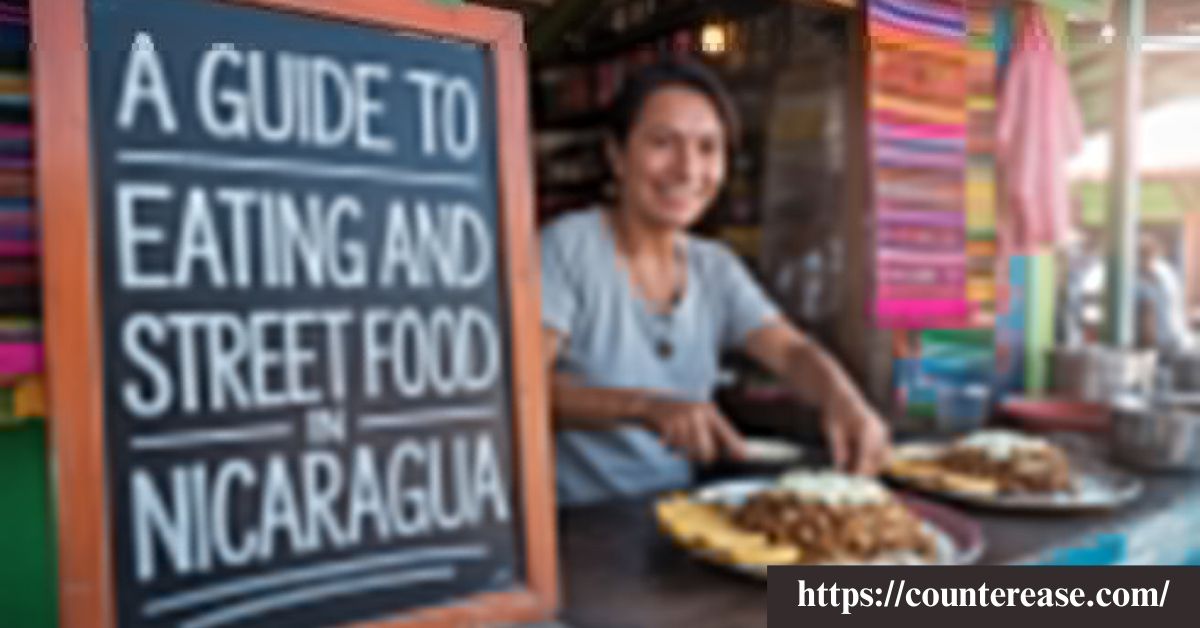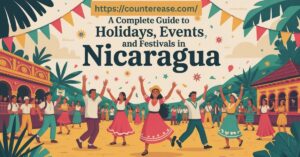The term food-cuisine-Nicaragua refers to the vibrant culinary traditions shaped by the country’s rich history, fertile lands, and coastal abundance.The food cuisine nicaragua blends Indigenous recipes, Spanish influences, and Caribbean flair into dishes bursting with flavor. Corn, beans, plantains, and tropical fruits form the foundation, while fresh seafood and aromatic spices elevate everyday meals into something truly special.
In Nicaragua, every bite tells a story of culture and community. Colorful markets brim with sizzling street stalls, where the aroma of grilled meats and fried plantains lingers in the air. From the crunch of vigorón to the creamy richness of quesillos, each dish invites you to experience authenticity that can’t be replicated anywhere else.
Exploring food-cuisine-Nicaragua is more than eating—ifood cuisine nicaragua is an immersion into tradition and lifestyle. Whether in the bustling streets of Granada or along the coconut-lined Caribbean coast, the flavors reveal the warmth, resilience, and joy of the people who create them.
Street Eats, Hidden Gems, and Culinary Treasures
Forget everything you think you know about Central American food. While Costa Rica gets the eco-tourism spotlight and Guatemala claims the archaeological fame, Nicaragua’s street food scene remains one of Latin America’s most authentic and undiscovered culinary treasures. This food cuisine nicaragua isn’t just another destination guide – food cuisine nicaragua’s your insider passport to a world where traditional dishes tell stories of indigenous heritage, colonial influence, and Caribbean soul.
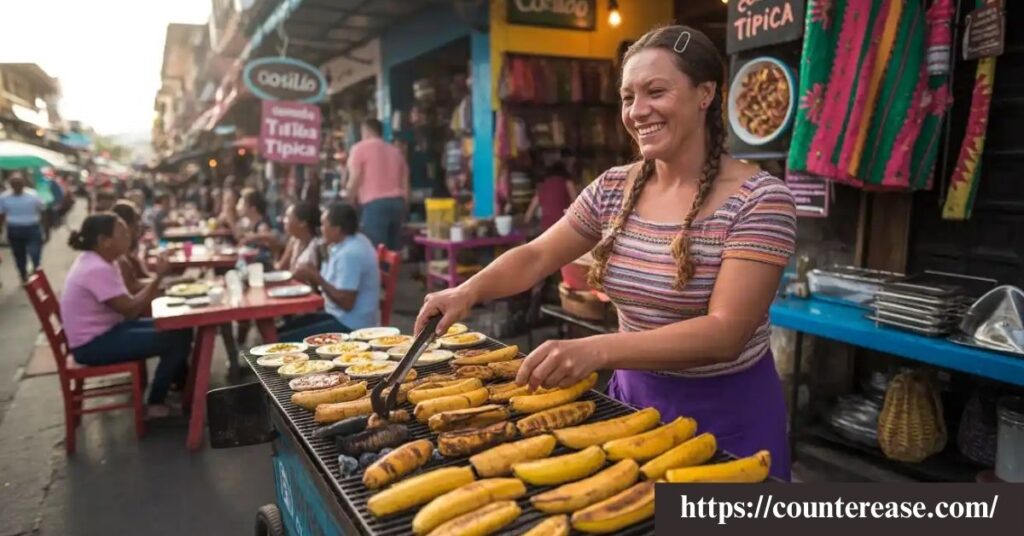
Nicaragua’s cuisine doesn’t shout for attention like its flashier neighbors. Instead,food cuisine nicaragua whispers secrets through corn masa, sings through fresh flavours, and celebrates with every bite of affordable meals that’ll leave you questioning why you ever paid $15 for a mediocre burrito back home.
Nicaragua’s Culinary Soul: Beyond the Tourist Trail
Political isolation became Nicaragua’s cuisine‘s greatest gift. While other Central American countries adapted their recipes for tourist palates, Nicaragua’s food culture remained beautifully, stubbornly authentic. The result? Traditional dishes that taste exactly like your Nicaraguan grandmother’s recipes – assuming you’re lucky enough to have one.
See Also: The Ultimate Packing List for a 7 Day Trip
Local ingredients form the holy trinity of Nicaraguan cooking: corn, beans, and plantains. But don’t mistake simplicity for boring. These humble ingredients in food cuisine nicaragua transform into complex flavor symphonies that showcase indigenous Miskito techniques, Spanish colonial influences, and Afro-Caribbean magic from the Atlantic coast.
The secret lies in the preparation methods of food cuisine nicaragua passed down through generations. Fresh flavours emerge from wood-fired stoves, hand-ground spices, and cooking techniques that refuse to bow to modern shortcuts. When you taste authentic gallo pinto made over an open flame at 5 AM in a Managua market, you’ll understand why Nicaraguans consider their breakfast superior to anything else in Central America.
Key Cultural Elements:
- Indigenous Miskito foundation with corn and beans
- Spanish colonial techniques and ingredients
- Afro-Caribbean influences from the Atlantic coast
- Minimal tourist adaptation preserving authenticity
- Wood-fire cooking methods still prevalent
Street Food Royalty: The Dishes That Define Nicaragua
The Holy Trinity of Nicaraguan Street Food
Nacatamales reign as weekend royalty in Nicaragua. These aren’t your typical Mexican tamales – they’re architectural marvels wrapped in banana leaves. Every nacatamal contains a universe: tender pork or chicken, rice, potatoes, onions, and sometimes olives or raisins, all nestled in perfectly seasoned corn masa. Families wake up before dawn on Saturdays to prepare these labor-intensive masterpieces, making them available only on weekends at most fondas.
Vigorón represents Nicaragua’s answer to the perfect hangover cure. Picture this: a generous portion of boiled yuca topped with crispy chicharrón (pork rinds) and curtido (pickled cabbage slaw), all served on a banana leaf plate. The combination sounds simple until you taste how the creamy yuca balances the salty crunch of perfectly rendered pork fat, while the tangy curtido cuts through the richness. León claims to serve the country’s best vigorón, but every region fiercely defends their version.
Quesillos might look like simple tortillas with cheese, but they’re edible poetry. Fresh white cheese gets wrapped in a warm corn tortilla with pickled onions and cream, creating a flavor bomb that costs less than a dollar. The best quesillos come from roadside stands where the cheese still holds warmth from recent milking, and the tortillas puff with steam when you bite them.
Breakfast Champions
Gallo pinto transcends its humble “rice and beans” description. This breakfast staple becomes Nicaragua’s national identity on a plate in food cuisine nicaragua. The magic happens in the preparation – day-old rice gets fried with red beans, onions, garlic, and a secret blend of spices that varies by family. Some add coconut milk on the Caribbean coast, while Pacific regions prefer a drier consistency. Served with fried cheese, sweet plantains, and scrambled eggs, gallo pinto provides sustenance for Nicaragua’s working class and comfort for homesick Nicas worldwide.
Indio viejo tells Nicaragua’s story through food. This beef stew with corn masa represents indigenous ingenuity – tough meat becomes tender through slow cooking with ground corn, while onions, garlic, and achiote add depth and color. The dish’s name translates to “old Indian,” honoring the indigenous roots that ground Nicaraguan identity. Traditional preparation involves hand-grinding the corn, though modern versions sometimes use prepared masa.
Afternoon Cravings
Tajadas prove that simplicity creates perfection. These fried green plantains arrive at your table golden and crispy, accompanied by cream or fresh cheese. The secret lies in achieving the perfect balance – crispy exterior yielding to creamy interior, while the slight bitterness of unripe plantain contrasts beautifully with rich dairy accompaniments.
Street Food Pricing Guide:
| Dish | Price Range (Córdobas) | Price Range (USD) | Best Time to Buy |
|---|---|---|---|
| Nacatamal | 50-80 | $1.35-2.15 | Saturday/Sunday morning |
| Vigorón | 30-50 | $0.80-1.35 | Lunch hours |
| Quesillo | 15-25 | $0.40-0.70 | Anytime |
| Tajadas | 20-35 | $0.55-0.95 | Afternoon snack |
| Gallo Pinto | 40-60 | $1.10-1.60 | Breakfast hours |
Sweet Obsessions: Nicaragua’s Dessert Underground
Nicaragua’s dessert culture operates on a different frequency than its savory counterparts. While street food dominates lunch and dinner conversations, sweets whisper their presence through family bakeries, market stalls, and grandmother’s kitchens.
Tres leches cake reaches its apex in Nicaragua. The country didn’t invent this Latin American classic, but they perfected it. Nicaraguan versions achieve impossible lightness – sponge cake so airy it barely exists, soaked in evaporated, condensed milk, and cream until every bite delivers pure dairy bliss. The best versions add a touch of rum or vanilla, elevating simple ingredients into dessert nirvana.
Pio Quinto represents Nicaragua’s boozy dessert royalty. This rum-soaked cake with custard and cinnamon requires patience – layers of sponge cake macerate in rum while custard sets to perfect consistency. Traditional recipes call for Flor de Caña rum, Nicaragua’s liquid gold, which adds caramel notes that complement the vanilla custard. Finding authentic Pio Quinto requires befriending local bakers or attending special celebrations.
Raspados provide tropical relief from Nicaragua’s heat. These shaved ice treats topped with fruit syrup and condensed milk might seem simple, but variety amazes. Vendors offer dozens of syrup flavors – from traditional strawberry and coconut to alluring combinations like tamarind-chili or hibiscus. The best raspados use natural fruit syrups made fresh daily, avoiding artificial colors that plague tourist versions.
Popular Raspado Flavors:
- Coconut with condensed milk
- Strawberry with fresh fruit pieces
- Tamarind-chili for heat lovers
- Hibiscus (jamaica) for floral notes
- Mixed fruit combinations
- Coffee for caffeine people with substance abuse disorder
Regional Food Capitals: Where Flavors Tell Stories
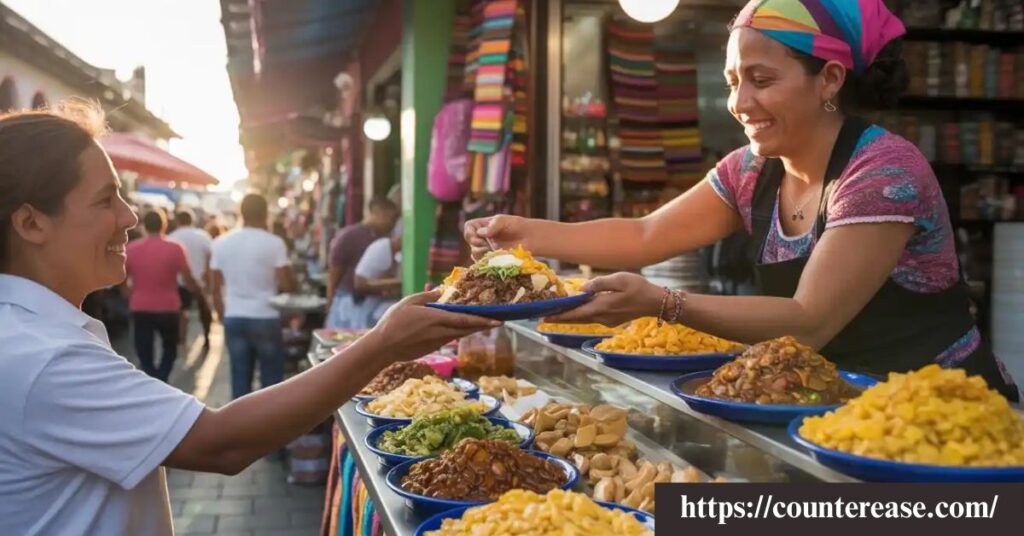
Managua: The Melting Pot
Managua doesn’t win beauty contests, but it dominates Nicaragua’s food scene. The capital’s markets serve as testing grounds where regional specialties compete for supremacy. Mercado Asian stretches across acres, housing thousands of vendors selling everything from alluring fruits to grandmother’s secret recipes.
The city’s street food reflects its role as Nicaragua’s crossroads. Here, you’ll find Pacific Coast seafood, Caribbean coconut preparations, and northern highlands cheese all competing for sidewalk space. Managua’s late-night food scene thrives around universities and bus terminals, where affordable meals fuel students and travelers.
Must-Try Managua Spots:
- Mercado Asian: Ultimate food adventure (go with locals)
- Mercado Huembes: Cleaner, tourist-friendly market
- University area: Budget-friendly student portions
- Terminal areas: 24-hour eating options
Granada: Colonial Elegance Meets Street Grit
Granada balances tourist expectations with authentic Nicaraguan cuisine. Calle La Calzada transforms every evening into a food parade, but venture beyond the tourist zone for real treasures. Local fondas hidden in residential neighborhoods serve traditional dishes at prices that’ll shock visitors accustomed to tourist markups.
Lake Nicaragua influences Granada’s cuisine significantly. Fresh fish preparations here differ from coastal versions – river fish like guapote and mojarra receive treatments that highlight their delicate flavors rather than masking them with heavy spices.
León: University Town, Serious Eats
León’s university population demands quantity without sacrificing quality. Filling portions at student prices create a competitive environment where only the best vendors survive. The city’s revolutionary history permeates its food culture – simple, honest preparations that satisfy working-class appetites.
León claims Nicaragua’s best vigorón, and after tasting versions throughout the country, the claim holds merit. León’s vigorón achieves perfect textural contrast – creamy yuca, perfectly crispy chicharrón, and curtido with just enough acidity to balance the richness.
Pacific Coast: Seafood Paradise
Pacific Coast towns like San Juan del Sur showcase Nicaragua’s maritime bounty. Fresh fish arrives daily from small boats, heading directly to beachside fondas where preparation stays simple. Ceviche here uses fish caught hours earlier, while whole grilled fish receives minimal seasoning to highlight natural flavors.
See Also: Review: Chelsea Lounge; American Airlines/British Airways First Class Flagship Lounge New York (JFK)
Rondón, though traditionally Caribbean, appears in Pacific coast variations. Pacific rondón typically features local fish varieties in coconut-milk based broths with yuca and plantains, creating hearty stews perfect for beach picnics.
Caribbean Coast: Afro-Caribbean Explosion
Caribbean Coast cuisine operates on different principles than Pacific Nicaragua. Coconut milk transforms ordinary ingredients into alluring dishes, while Creole influences add complexity absent from western Nicaragua. Bluefields and surrounding communities preserve Afro-Caribbean traditions that create unique fusion cuisine.
Pan de coco (coconut bread) represents Caribbean coast baking excellence. This sweet, dense bread incorporates fresh coconut and sometimes tropical fruits, creating breakfast treats that pair perfectly with strong coffee. Traditional preparation uses wood-fired ovens that impart smoky notes complementing coconut sweetness.
Treasure Map: Where Locals Actually Eat
Markets That Matter
Mercado Asian in Managua intimidates newcomers but rewards brave explorers. This massive marketplace operates on controlled chaos principles – thousands of vendors selling everything imaginable while food stalls scattered throughout serve authentic traditional dishes. Navigation requires local guidance initially, but the adventure yields incredible affordable meals and cultural education.
Safety tip: Visit Mercado Asian with local guides initially. The market’s size and activity can overwhelm visitors, while guides help navigate both geography and social customs.
Granada’s Mercado Municipal offers tourist-friendly authenticity. Cleaner than Managua’s massive market but maintaining genuine local atmosphere, Granada’s central market provides comfortable introduction to Nicaraguan market culture. Fresh flavours abound as vendors compete for both tourist and local customers.
León’s Mercado Central caters to university budgets while maintaining quality standards. Student populations demand value, creating competitive environments where filling portions and affordable meals become standard expectations.
Street Corners Worth Finding
Nicaraguan street food operates on mobility principles. The best vendors move throughout cities following customer patterns – business districts during lunch, residential areas during dinner, entertainment zones at night. Social media revolutionized vendor tracking, with local Facebook groups sharing real-time locations for popular mobile fondas.
Timing Strategy:
- Morning (6-9 AM): Gallo pinto and breakfast specialists
- Lunch (11 AM-2 PM): Vigorón, nacatamales on weekends
- Afternoon (3-6 PM): Tajadas, sweet treats, raspados
- Evening (7-10 PM): Quesillos, dinner combinations
- Late night: University areas, terminal zones
Survival Guide: Eating Smart in Nicaragua
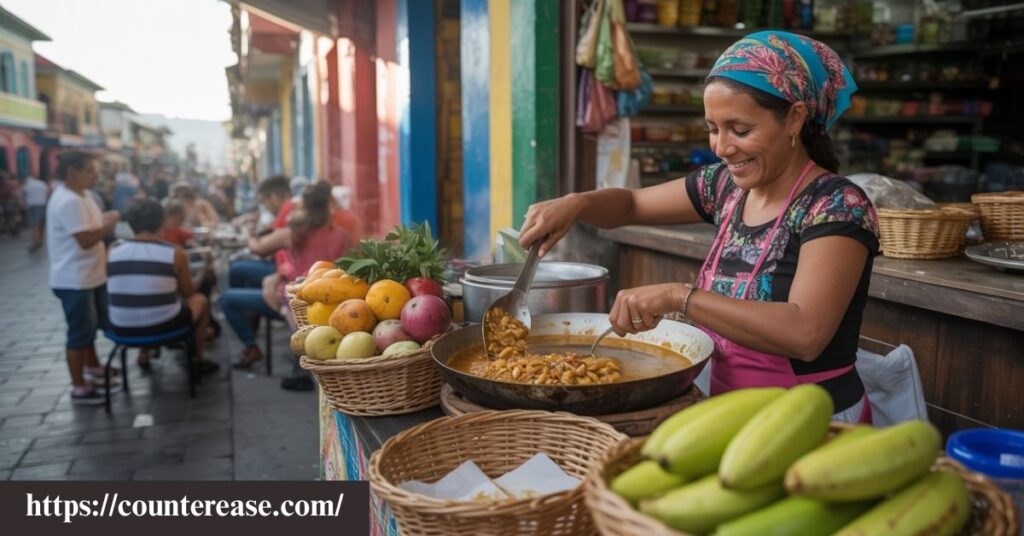
Safety Without Paranoia
Nicaraguan street food safety follows simple principles that unreasonable guidebooks overcomplicate. Local vendors feeding neighborhood customers daily maintain reputations through consistent quality and safety. Look for busy stalls with rapid turnover – long queues indicate both popularity and hygiene standards that keep locals returning.
Hot, freshly cooked food provides the safest options. Avoid items sitting under heat lamps for extended periods, but don’t fear freshly prepared dishes. Nicaraguan vendors take pride in their reputations and understand that sick customers mean lost business.
Hydration becomes crucial in Nicaragua’s tropical climate. Bottled water remains the safest choice, though coconut water straight from the source provides natural electrolyte replacement. Avoid ice in drinks unless you’re confident about water sources.
See Also: 15 Things to Do in Panajachel, Lake Atitlan, Guatemala
Smart Eating Rules:
- Choose busy vendors with local customers
- Prefer hot, freshly cooked items
- Trust your instincts about cleanliness
- Stay hydrated with bottled water
- Start slowly with spicy foods if sensitive
Money Matters
Nicaragua operates on dual currency systems in many areas. Córdobas provide better value for street food, while dollars often receive unfavorable exchange rates from vendors. Small denominations work best – carrying 500 córdoba notes to buy 20 córdoba quesillos creates unnecessary complications.
Tipping culture for street food vendors differs from restaurant expectations. Small tips (5-10 córdobas) show appreciation but aren’t mandatory. Regular customers often receive better portions and service, so building relationships with favorite vendors pays dividends.
Daily Food Budget Guide:
| Budget Level | USD Amount | Córdoba Amount | What You Get |
|---|---|---|---|
| Budget | $5 | 180 C$ | Basic traditional dishes, street food only |
| Comfortable | $10 | 370 C$ | Multiple street food items, drinks, desserts |
| Generous | $15 | 550 C$ | Restaurant meals plus street food exploration |
Cultural Navigation
Nicaraguan dining etiquette emphasizes respect and patience. Vendors appreciate customers who wait politely, speak basic Spanish, and show interest in their food. Simple phrases like “¿Qué me recomienda?” (What do you recommend?) often unlock better service and insider recommendations.
Essential Spanish Food Vocabulary:
- ¿Cuánto cuesta? – How much does it cost?
- Sin chile – Without chili/spice
- Más picante – More spicy
- Para llevar – To go
- ¿Qué ingredientes tiene? – What ingredients does it have?
- Está delicioso – It’s delicious
Frequently Asked Questions
“Is it safe to eat street food in Nicaragua?”
Absolutely, with common sense precautions. Nicaragua’s street food culture thrives because vendors maintain quality standards that keep neighborhood customers returning daily. Choose busy stalls serving hot, freshly cooked food, and you’ll eat better than many restaurants at fraction of the cost. Millions of Nicaraguans eat street food daily without issues.
“What’s the deal with breakfast? Why is everything so heavy?”
Nicaraguan breakfast reflects the country’s agricultural heritage and working-class needs. Gallo pinto with eggs, cheese, and plantains provides sustained energy for physical labor that dominates Nicaragua’s economy. Traditional dishes evolved to fuel long workdays, not office jobs. Start with smaller portions if you’re not accustomed to hearty food in the morning.
“Can vegetarians survive Nicaragua’s meat-heavy culture?”
Vegetarian options exist but require creativity and Spanish skills. Gallo pinto, tajadas, quesillo (ask for cheese-only versions), and various fruit preparations provide meatless options. Markets offer incredible produce variety, while some fondas prepare vegetarian versions of traditional dishes upon request. Caribbean coast regions offer more plant-based variety through tropical fruits and coconut preparations.
“How spicy is too spicy for sensitive stomachs?”
Nicaraguan cuisine favors flavor over heat, unlike Mexican food culture. Most traditional dishes use mild seasonings, with spicy condiments served separately. Chile usage remains moderate compared to other Central American countries. When ordering, specify “sin chile” if you prefer mild food, or “poco picante” for slightly spicy options.
“What’s the one dish I absolutely cannot leave without trying?”
Vigorón represents Nicaragua’s soul food – yuca with chicharrón and curtido showcases the country’s ability to transform simple local ingredients into complex flavors. It’s affordable, available everywhere, and embodies Nicaraguan comfort food traditions. Plus, the banana leaf presentation adds authentic cultural experience.
“How different is this from Costa Rican or Honduran food?”
Nicaragua’s cuisine maintains stronger indigenous influences and less tourist adaptation than Costa Rican food. Honduran cuisine shares some dishes but differs in preparation methods and spice usage. Nicaraguan food emphasizes corn masa preparations more heavily, while maintaining simpler seasoning profiles that highlight fresh flavours rather than masking them.
Your Nicaraguan Food Adventure Starts Now
Nicaragua’s street food scene rewards adventurous eaters with authentic experiences impossible to find elsewhere in Central America. Traditional dishes prepared with centuries-old techniques, fresh flavours from local ingredients, and affordable meals that cost less than coffee shop drinks create culinary adventures worth planning trips around.
Start your exploration in markets where vendors compete daily for local approval. Trust long queues as quality indicators, embrace the controlled chaos of Mercado Asian, and remember that the best fondas often hide in residential neighborhoods where tourists never venture.
Support local food culture by choosing street food over international chains, learning basic Spanish food vocabulary, and showing respect for vendors who preserve Nicaragua’s culinary heritage. Every córdoba spent on authentic traditional dishes supports families and communities maintaining food traditions against globalization pressure.
Your Nicaragua Food Adventure Checklist:
- Download Spanish translation apps for menu navigation
- Research local Facebook groups sharing vendor locations
- Pack antacids for rich food adjustment period
- Bring small bills in córdobas for easy transactions
- Keep open minds about trying unfamiliar tropical ingredients
- Take photos respectfully and share your discoveries
Nicaragua’s street food culture represents more than mere sustenance – it’s edible history, cultural preservation, and community building served on banana leaves. Every bite connects you to indigenous traditions, colonial influences, and Caribbean creativity that shaped this remarkable country.
See Also: A Full Guide to the Cost of Living in Argentina
The adventure begins with your first quesillo from a roadside stand, continues through weekend nacatamal hunts, and never really ends. Nicaragua’s cuisine creates food memories that’ll haunt your kitchen experiments and fuel return trip planning for years to come.
FAQs
1. What are the most popular street foods in Nicaragua?
Vigorón, quesillos, tajadas, nacatamales, and gallo pinto are among the most beloved street foods.
2. Is Nicaraguan street food safe to eat?
Yes, if you choose stalls with high turnover, good hygiene, and freshly cooked food served hot.
3. How much does street food cost in Nicaragua in 2025?
Prices typically range from $1 to $3 USD per dish, depending on the location and portion size.
4. Are vegetarian options available in Nicaraguan street food?
Yes, dishes like gallo pinto, fried plantains, and cheese-filled tortillas are vegetarian-friendly.
5. Where can I find the best street food in Nicaragua?
Major cities like Managua, Granada, León, and Masaya’s markets offer excellent street food selections.
Conclusion
The food-cuisine-Nicaragua offers a true taste of the country’s heart and soul. From humble street stalls to bustling markets, every dish reflects tradition, creativity, and love for fresh ingredients. The mix of Indigenous flavors, Spanish heritage, and Caribbean influences creates meals that are both comforting and full of character. Whether it’s a warm nacatamal in the morning or crispy tajadas in the afternoon, each bite connects you to Nicaragua’s culture.
Travelers who explore food-cuisine-Nicaragua discover more than just meals—they experience a way of life. Sharing food is part of the local identity, and every vendor takes pride in their recipes. Eating here means tasting history, celebrating community, and enjoying flavors that linger in memory long after the trip ends. For anyone visiting, trying street food is not just recommended—it’s an essential part of understanding Nicaragua.
Welcome to Central America’s most authentic culinary secret. Nicaragua awaits your appetite.

Asia Jenni is a passionate travel writer and expert author on CounterEase.com. With a deep love for exploration, she shares insightful travel guides, tips, and destination recommendations, helping travelers discover new places with ease. Her expertise in curating memorable trips and her engaging writing style make her a valuable resource for anyone looking to plan their next adventure.
